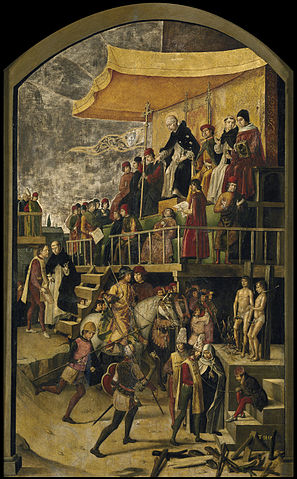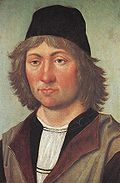
File:Pedro Berruguete - Saint Dominic Presiding over an Auto-da-fe (1475).jpg

Size of this preview: 297 × 479 pixels.
| |
This is a file from the Wikimedia Commons. Information from its description page there is shown below.
Commons is a freely licensed media file repository. You can help. |
Summary
| Artist |
|
|||||||||||||||||||||||
| Description |
Saint Dominic Presiding over an Auto-da-fe. From the sacristy of the Santo Tomás church in Ávila.
|
|||||||||||||||||||||||
| Date | circa 1495 | |||||||||||||||||||||||
| Medium | oil on panel | |||||||||||||||||||||||
| Dimensions | 154 × 92 cm (60.6 × 36.2 in) | |||||||||||||||||||||||
| Current location |
|
|||||||||||||||||||||||
| Accession number | catalog number P00618 | |||||||||||||||||||||||
| Notes | Representations of an auto da fe often depict torture or someone being burnt at the stake. The two victims in the lower right, tied to the two posts are resting on two stakes driven horizontally into the posts behind them, meant to prolong their deaths by staving off suffocation by the ropes or garrotes wrapped around their necks. Another likely purpose of these stakes was possibly a means of further shaming and humiliating the victims, due to their apparently intentional resemblance to the human male anatomy. The two victims on the posts await their deaths as the pile of ignited firewood before them is fed and fueled sufficiently to attain the desired result. The two victims standing in line await their own turns next on the posts. All of these victims are Cathars, allegedly St. Dominic's primary targets. Some defenders of St. Dominic dispute the likelihood that the saint ever acted as an inquisitor. Painted in the late 1400's, it depicts an episode in the life of St. Dominic from nearly 300 years earlier. In Pedro Berruguete's 15th century Spain, auto da fe's were still a fairly routine and commonplace event and thus many elements of the painting most probably portray one or more real life events as directly witnessed by the artist himself. It is of interest to note what may have been some subtle but distinct forms of protest incorporated into the painting by the artist: first in the artist's decision to place a few sleeping or drowsy attendants in the work, secondly one can note the only figure in the entire painting who was portrayed with a "fully open mouth" while speaking happens to be the one Cathar who is next in line for execution! Later, during the Protestant Reformation, this painting was used for anti-Catholic propaganda. A very high definition file of the painting is available at the Prado site. Also, by clicking on the file it will enlarge significantly. | |||||||||||||||||||||||
| Source/Photographer | ||||||||||||||||||||||||
| Permission ( Reusing this file) |
|
|||||||||||||||||||||||
derivative works
Derivative works of this file:
File usage
The following pages on Schools Wikipedia link to this image (list may be incomplete):
Metadata
This file contains additional information, probably added from the digital camera or scanner used to create or digitize it. If the file has been modified from its original state, some details may not fully reflect the modified file.
| Width | 2,350 px |
|---|---|
| Height | 3,790 px |
| Bits per component |
|
| Compression scheme | Uncompressed |
| Pixel composition | RGB |
| Orientation | Normal |
| Number of components | 3 |
| Horizontal resolution | 310 dpi |
| Vertical resolution | 310 dpi |
| Data arrangement | chunky format |
| Software used | Adobe Photoshop CS2 Windows |
| File change date and time | 13:47, 25 January 2008 |
| Colour space | Uncalibrated |
| Image height | 1,892 px |
| Image width | 3,051 px |
| Date and time of digitizing | 15:23, 23 January 2008 |
| Date metadata was last modified | 14:47, 25 January 2008 |
| IIM version | 2 |
I want to learn more...
Wikipedia for Schools was collected by SOS Children. The world's largest orphan charity, SOS Children brings a better life to more than 2 million people in 133 countries around the globe. Have you heard about child sponsorship? Visit our web site to find out.




